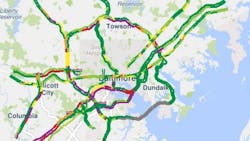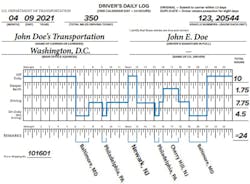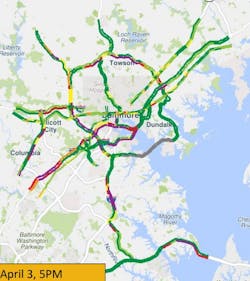Baltimore bridge collapse: New information, resources for CMV drivers
In the wake of the Francis Scott Key Bridge collapse, the trucking and supply chain industries have questions and concerns.
In a recent webinar by the Federal Motor Carrier Safety Administration, FMCSA revealed new information and resources for those in the industry feeling the effects of the bridge collapse that occurred on March 26 in Baltimore, Maryland.
Short-haul ELD exception
There is currently a short-haul exception for commercial vehicle drivers who operate within a 150-air-mile radius of the Port of Baltimore. During the webinar, FMCSA explained that the exception “allows a driver to use a time record in place of an electronic or paper Record of Duty Status, provided the specific rule provisions are met.”
This exception is only for short-haul drivers who are dispatched from and return to the same work location each day, according to FMCSA's Stacy Ropp.
This exception has strict hours of operation rules for drivers. Drivers must have 10 consecutive hours off-duty after 14 hours on-duty. Drivers who don’t meet the terms of the short-haul exception must complete an RODS per day of operation as soon as the exception no longer applies.
FMCSA states that “if using this emergency declaration, a paper RODS, also known as a logbook, may be completed instead of recording time worked on an ELD.”
RODS must be completed each day, and drivers must keep each RODS in their vehicle with them for seven days.
Drivers must submit RODS and supporting documents to their motor carrier within 13 days. Motor carriers must keep these records for six months. A supporting document can include the following, according to FMCSA:
- Bill of lading/ manifest/shipping paper
- Fuel receipts
- Toll receipts and/or EZ Pass statements
- Terminal interchange receipt
Driving limits
The following limits are in place for drivers traveling in the Port of Baltimore area, according to FMCSA:
- 11-hour driving limit: May drive a maximum of 11 hours after 10 consecutive hours off-duty.
- 14-hour driving limit: May not drive beyond the 14th consecutive hour after coming on-duty, following 10 consecutive hours off-duty. Off-duty time does not extend the 14-hour period.
- 30-minute driving break: Drivers must take a 30-minute break when they have driven for a period of 8 cumulative hours without at least a 30-minute interruption. The break may be satisfied by any non-driving period of 30 consecutive minutes (i.e., on-duty not driving, off-duty, sleeper berth, or any combination of these taken consecutively).
- 60/70-hour limit: May not drive after 60/70 hours on duty in 7/8 consecutive days. A driver may restart a 7/8 consecutive-day period after taking 34 or more consecutive hours off-duty.
These limits are waived for any transportation assisting in the restoration and cleanup of the Port of Baltimore.
See also: How Maryland fleets are faring after the Baltimore bridge collapse
Traffic congestion
As expected, FMCSA reports traffic slowdowns in the Port of Baltimore. Ropp reports an increase in traffic congestion on the western sides of I-95, I-895, and I-695 since the Francis Scott Key Bridge collapse.
FMCSA will continue to monitor traffic congestion in the area and provide the commercial vehicle industry with the information needed for route planning. FMCSA also recommends visiting the Maryland Department of Transportation website for up-to-date traffic alerts and routing information.
Resources
For additional information about the status of the Port of Baltimore for trucking, traffic congestion, and additional commercial vehicle information related to the Port of Baltimore, FMCSA recommends the following resources:
More FSK Bridge coverage from EBM
FleetOwner affiliates within Endeavor Business Media are covering the Francis Scott Key Bridge collapse from various business standpoints. Here is a roundup of coverage from EBM, the largest B2B publisher in the U.S.
Port Baltimore Disrupts Equipment Supply: Imports of construction equipment and parts are being affected by the collapse of the Francis Scott Key Bridge in Baltimore
—Construction Equipment
Supply Chain Implications of Baltimore Bridge Collapse: The Port of Baltimore is the ninth biggest port for international cargo in the U.S.
—Material Handling & Logistics
President Biden to Visit Key Bridge Site Friday: President Joe Biden is scheduled to visit Baltimore on Friday to get “on the ground look.”
—Roads & Bridges
Crews Work to Open Port Baltimore: Bridge cleanup could create a temporary channel and allow continued search efforts
—Roads & Bridges
After Francis Scott Key Bridge Collapse–What are Safety Implications?: ARTBA notes that about one in three bridges need replacement
—EHS Today
Timeline of Francis Scott Key Bridge Collapse: A minute-by-minute account of the collapse
—Firehouse
Local Marina Open 24/7 to Support Baltimore Bridge Collapse Responders: Anchor Bay East is located a mile away from the FSK Bridge collapse and is being used by workers for breaks and to fuel boats
—Firehouse
Divers Find Two Bodies in Truck Amid Tangled MD Bridge Debris: The remaining victims will be extricated via salvage operation
—Firehouse
NTSB Investigating Key Bridge Collapse: Structure was "fully up to code."
—Roads & Bridges
Key Bridge Collapse Leads to Long Commutes in Baltimore: I-695 is a major transportation artery
—Roads & Bridges
Port Blocked by Baltimore Bridge Collapse is Key Hub for U.S. Shipping: The Port of Baltimore's vehicles terminals moved over 750,000 vehicles in 2022
—Industry Week
How the Baltimore bridge collapse impacts trucking: Trucking operations are forced to navigate travel restrictions around a major East Coast traffic area
—FleetOwner
Listen: Cargo Ship Collapses Baltimore Bridge, Sending 7 Vehicles into Water: The Maryland Transportation Authority Police dispatch and response to the Key Bridge Collapse
—Officer
About the Author

Jenna Hume
Digital Editor
Digital Editor Jenna Hume joined FleetOwner in November of 2023 and previously worked as a writer in the gaming industry. She has a bachelor of fine arts degree in creative writing from Truman State University and a master of fine arts degree in writing from Lindenwood University. She is currently based in Missouri.


